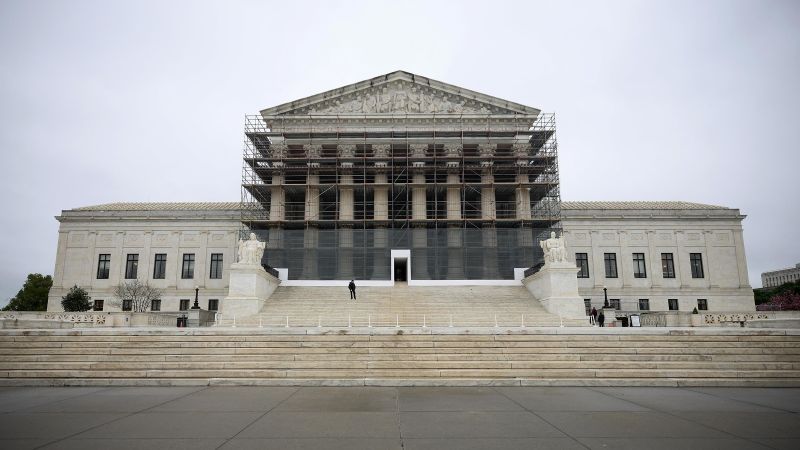CNN
—
The Supreme Court on Thursday said President Donald Trump doesn’t have to rehire senior officials he fired from two independent federal labor agencies that enforce worker protections, while the officials continue fighting in court to reverse their terminations.
The court, in its unsigned opinion, notably said its decision doesn’t implicate the Federal Reserve, differentiating it from the lesser-known labor agencies at stake in the case.
The officials were already taken off the job in early April when Chief Justice John Roberts issued an administrative order to temporarily pause their reinstatement while the full Supreme Court reviewed the matter. The latest decision extends their dismissal, perhaps forever, if the lower courts reviewing the matter don’t rule again in their favor.
This is a significant victory for Trump and his efforts to assert control over federal agencies that Congress designed to be independent from White House meddling. The ruling is temporary but shows that the justices are receptive to Trump’s claims of vast presidential power over hiring decisions and may side with him if the case returns to the high court.
“Because the Constitution vests the executive power in the president,” the court wrote in its unsigned opinion, “he may remove without cause executive officers who exercise that power on his behalf, subject to narrow exceptions recognized by our precedents.”
The Supreme Court’s three liberal justices – Elena Kagan, Sonia Sotomayor and Ketanji Brown Jackson – dissented.
The officials are Cathy Harris, former chair of the Merit Systems Protection Board, which reviews federal firings and can reinstate wrongly terminated workers, and Gwynne Wilcox, a member of the National Labor Relations Board. Both women are Democrats and were appointed by former President Joe Biden to statutory terms that weren’t set to expire for years.
The decision to side with Trump on a temporary basis, the court wrote Thursday, “reflects our judgment that the government is likely to show that both the NLRB and MSPB exercise considerable executive power,” though it said it wasn’t deciding, at this stage, the question of whether the agencies fall within those exceptions.
The court went out of its way to directly shoot down an argument raised by Harris and Wilcox that a ruling against them could have consequences for other independent agencies – especially the Federal Reserve, which has enormous sway over the nation’s economy. That’s because the Fed is essentially structured the same way as other independent agencies that Trump has targeted.
“We disagree,” the court said, echoing an argument Trump raised throughout the case. “The Federal Reserve is a uniquely structured, quasi-private entity that follows in the distinct historical tradition of the First and Second Banks of the United States.”
By pointing to the potential impact on the Fed, the labor officials were upping the stakes, calling attention to a much higher profile agency that the Supreme Court has already signaled it is reticent to upend.
Trump officials have rejected the idea that the labor cases have anything to do with the central bank, noting that the Supreme Court itself has suggested that the Federal Reserve may be a special case. Outside of court, however, Trump has openly called for the ouster of Fed Chairman Jerome Powell.
The president subsequently said on April 22 that he had “no intention of firing” Powell.
Writing for the dissenting justices, Kagan said the majority had effectively allowed Trump to overrule a decades-old Supreme Court case, Humphrey’s Executor v. US, that allowed Congress to require presidents to show cause – such as malfeasance – before dismissing board members overseeing independent agencies.
“What matters,” Kagan wrote, “is not that Wilcox and Harris would love to keep serving in their nifty jobs. What matters instead is that Congress provided for them to serve their full terms, protected from a president’s desire to substitute his political allies.”
She also rejected the majority’s argument that the court’s decision would not impact the Federal Reserve, saying that “the creation of a bespoke Federal Reserve exception” should not reassure investors wary of meddling by Trump.
“If the idea is to reassure the markets, a simpler – and more judicial – approach would have been to deny the President’s application for a stay on the continued authority of Humphrey’s,” she wrote.
Agencies at a standstill
With both officials still on the sidelines, their respective agencies lack a quorum and can’t fully function. This slows their ability to process federal employees’ grievances and issue final rulings in disputes.
In the first weeks of Trump’s administration, he sent termination letters to Harris and Wilcox. They both sued in federal court, arguing that federal laws make clear that they can only be fired for cause, and not simply because the president wishes to replace them.
District judges agreed with the officials, and reinstated both of them in March.
At the behest of the Justice Department, a federal appeals panel temporarily removed them, ruling that presidents have broad powers to fire executive branch leaders. The officials were briefly reinstated after the full appeals court wiped away that ruling, only to be removed again last week by Roberts’ administrative pause. The latest Supreme Court ruling keeps them off the job.
In a recent hearing, a panel from the DC Circuit Court of Appeals appeared likely to give Trump more powers to fire leaders of congressionally created independent agencies within the executive branch. That two-hour hearing was about the underlying merits of the lawsuit, and not the emergency stay that was just ruled on by the Supreme Court.
This story has been updated with additional developments.

